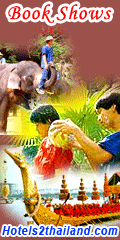 Chiang Mai, with an altitude of approximately 310 meters above sea level, is situated approximately 700 kilometers from Bangkok on the Mae Ping River basin. Surrounded by high mountain ranges, the city covers an area of approximately 20,107 square kilometers and is the country’s second largest province. Chiang Mai borders Myanmar on the north, Lamphun and Tak Provinces on the south, Chiang Rai, Lampang and Lamphun Provinces on the east and Mae Hong Son Province on the west. The terrain is mainly comprised of jungles and mountains, which are home to the hill tribes. In addition, wildlife and exotic flora may be found in the national parks.Most of Chiang Mai’s mountains are oriented from north to south. Together they create a multitude of streams and tributaries including Mae Chaem, Mae Ngat and Mae Klang. One of Chiang Mai’s distinctive features is Doi Inthanon, Thailands highest peak, which is 2,575 meters above sea level. In addition, the province boasts flat, fertile valleys, which spread along the banks of the largest and most important river in Chiang Mai Mae Nam Ping (Ping River) which originates from the Chiang Dao mountain range
Chiang Mai, with an altitude of approximately 310 meters above sea level, is situated approximately 700 kilometers from Bangkok on the Mae Ping River basin. Surrounded by high mountain ranges, the city covers an area of approximately 20,107 square kilometers and is the country’s second largest province. Chiang Mai borders Myanmar on the north, Lamphun and Tak Provinces on the south, Chiang Rai, Lampang and Lamphun Provinces on the east and Mae Hong Son Province on the west. The terrain is mainly comprised of jungles and mountains, which are home to the hill tribes. In addition, wildlife and exotic flora may be found in the national parks.Most of Chiang Mai’s mountains are oriented from north to south. Together they create a multitude of streams and tributaries including Mae Chaem, Mae Ngat and Mae Klang. One of Chiang Mai’s distinctive features is Doi Inthanon, Thailands highest peak, which is 2,575 meters above sea level. In addition, the province boasts flat, fertile valleys, which spread along the banks of the largest and most important river in Chiang Mai Mae Nam Ping (Ping River) which originates from the Chiang Dao mountain range


For years, tourists have mistaken Chiang Mai as the northern junction and the base from which they can explore other provinces. The phrase "a day in Chiang Mai is enough to see things around" was common. Today, tourists are surprised by the fact that there is always something new to discover Chiang Mai. Intriguing diversity among ethnic tribes coupled with breathtaking scenery makes Chiang Mai one of Asia’s most attractive tourist destinations. Two weeks in Chiang Mai may not be long enough for serious travelers.The old city of Chiang Mai with its fascinating indigenous cultural identity such as diverse dialects, cuisine, architecture, traditional values, festivals, handicrafts and classical dances is a prime location in its own right. In addition, the presence of hill tribes and their wealth of unique cultures enhance Chiang Mai’s distinctive diversity.
Chiang Mai is also blessed with pristine natural resources of mountains (dois), waterfalls, and other nature-based tourist attractions. At the same time, Chiang Mai residents are warm, gracious and congenial providing authentic hospitality making visits memorable and meaningful. Moreover, visitors from all walks of life can collect handicrafts of silk, silver and wood produced locally as timeless souvenirs. Chiang Mai is a place where both backpackers and luxury tourists can enjoy themselves to the fullest.
What's attraction in Chiang Mai
Doi Inthanon National Park

This national park which covers an area of 1,005 square kilometers is located on Doi Inthanon, Thailand’s highest mountain which is 2,565 meters above sea level. Located between Mae Chaem and Chom Thong, the park is comprised of the largest tract of upper mountain forest which ranges across Nepal, Bhutan, Myanmar, and ends in Northern Thailand. The mountain ranges gave birth to the main tributaries of the Ping river and formed the beautiful waterfalls, namely Siriphum, Wachirathan, Mae Pan, Mae Klang and Mae Ya. The moist and dense evergreen forest is abundant with lichens and wild orchids. The park is also a paradise for bird lovers. Visiting Doi Inthanon is possible throughout the year however, the best period for viewing the waterfalls is May through November while the best period for viewing wild flowers is December through February and for ornithologists is November through March.
Getting there: Travel 58 kilometres west of Chiang Mai via Highway No. 108 to Chom Thong, then turn right into Highway No. 1009 and continue a further distance of 48 kilometres along Highway No. 1009 to the summit. A good asphalt road takes visitors up but is rather steep, thus the vehicle must be in a good condition. Visitors could pay for the entrance fee at Km. 8. Doi Inthanon can be reached by a local truck (Song Thaeo) from Phra That Chom Thong or Mae Klang Waterfall. The Song Thaeo runs to Doi Inthanon National Park Office (Km. 31) and neighbouring villages. A chartered Song Thaeo costing around 800 baht can make stops at other attractions around the area.
Admission : adult 400 baht, child 200 baht
Facilities :Accommodation, restaurants, and camping sites are available at the park headquarters at Km. 31.
Tel: 0 5335 5728 , 0 5326 8550 , 0 5326 8550 , 0 5326 8577
Bangkok Tel: 0 2562 0760 or http://www.dnp.go.th/
Attractions in Doi Inthanon National Park

Namtok Mae Ya is one of the most beautiful cascades in Chiang Mai. Water flows from a 280-metre steep cliff onto different rock formations in a lower basin like drapes. The well-managed waterfall is teeming with verdant forests and is best for recreation. It is located 1 kilometre from Highway No. 1009 junction, turn left for 14 kilometres and then take a 200-metre walk.
Namtok Mae Klang is a 100-metre one-level waterfall located 8 kilometres from Highway No. 1009 junction and turn left onto an asphalt road for 500 metres.
Tham Bori Chinda is a large cave located near Namtok Mae Klang at Km. 8.5 of Highway No. 1009. The road sign to Tham Bori Chinda will be seen at the junction on the right. The deep cave has stalactite and stalagmite formations, Buddha images and a rocky stream. The surface of the water glitters like diamonds flake when light reflects the stream. Sunlight in the cave allows visitors to see the entire cave. The Tourist Centre at Km. 9 has exhibits on nature and animals that inhabit the area.
Namtok Wachirathan is a large waterfall which plummets over the edge of a high cliff into a deep pool below. When there is a large amount of water, there are large splashes in the basin, creating a cool and refreshing environment. The delightful ambience can be felt by walking on a slippery bridge that leads to the waterfall. To get there, turn right off Highway No.1009 at Km. 21, then follow the signpost to the waterfall a further 350 metres on foot. At Km.20 a new road is built to reduce the walk to the waterfall.
Namtok Siriphum is a splendid waterfall that falls from a steep cliff in two lines and can be seen en route to Doi Inthanon. The attractive waterfall is located at Km. 31 of Highway No. 1009, take a right turn for 2 kilometres and is approachable only on foot from the base of the waterfall.
Doi Inthanon Royal Project is in Khun Klang village close to the park headquarters. The project was initiated in 1979 to help the hill tribes to cultivate cash crops other than opium and train them on modern agricultural practices. Most produces are temperate zone plants. Flower plantations, a plant breeding research lab and flower plantations of hill tribes (Hmong) are open to visitors.

Phumisiri, twin pagodas located at Km. 41.5, were built to commemorate the fifth cycle birthdays of King Bhumibol Adulyadej and Queen Sirikit. Both pagodas share the similar bases as well as a two-level walking path that surrounds them. The pagodas enshrine Lord Buddha’s ashes and Buddha images, and overlook the magnificent scenery of Doi Inthanon
Doi Inthanon Peak has a cool climate all year round. The Air Force Radar Station and King Inthawichayanon’s stupa located on the mountaintop. King Inthawichayanon, the last king of Chiang Mai, was concerned about the importance of forests and wanted to preserve the forests for future generations. He was so familia with Doi Inthanon that he asked that part of his ashes be kept here. The Tourist Information Centre, near the top of Doi Inthanon, exhibits a chronological background of the mountain, including its geography, biology, forests, and animals.
Namtok Mae Pan is the longest waterfall in Chiang Mai, which flows from a 100-metre cliff. Its charm can be enjoyed by standing some distance from the falls. From afar, the white water and the green forests around the falls make a beautiful picture. From Km. 38 of Highway No. 1009, drive along the Doi Inthanon-Mae Chaem road (Highway No. 1192) for 6 kilometres and a sign to the waterfall will be seen, then drive on an unpaved road for 9 kilometres. The lovely waterfall can be reached by a ten-minute walk from a parking lot. In the rainy season, the road to Namtok Mae Phan is in a poor condition; only a four-wheel vehicle could make the journey.
Namtok Huai Sai Lueang is beyond Namtok Mae Pan, about 21 kilometres from Doi Inthanon-Mae Chaem Road. Turn left to an unpaved road where only a four-wheel vehicle could make a trip in the rainy season. The medium-size cascade has water all year round and flows from a cliff to each level.
Natural Study trek on Doi Inthanon Kiu Mae Pan starts from Km. 42. This short trail, winding through pristine forest for about 2.5 kilometres, a 3-hour walk, allows the hiker to experience the natural beauty of the forest at first hand. The Rhododendrons, commonly found in the Himalayas, are found along the trail and they are in full bloom during December-February. Trekkers on this route should seek permission from the park headquarters at Km. 31 for safety reasons. A group of not more than 15 people is recommended. Food consumption is not allowed while trekking. This nature trail is closed for reforestation from June 1 to October 30 annually.
Ang Ka Luang Nature Trail was surveyed and designed by Mr. Michael MacMillan Walls, a Canadian volunteer biologist who devoted to his work and died from a heart attack on this mountain. This trail is 360 metres long, passing through wet and cold areas in a lush valley. Forest above 2,000 metres is covered with lichens and wild orchids. Indigenous plants that needs a high level of nutrition, organic deposits, and rare species of birds are seen along the trail. There are more nature trails on Doi Inthanon, each providing different views of the diversity of plants, reforestation, the importance of tributaries, the origin of caves, hilltribe agriculture, and birdwatching. Walking trails range from 1 to 8 kilometres. Each trip needs approval from the Chief of the National Park and a trekking leader is needed. The service is obtained at the Park Office at Km. 31
Birdwatching on Doi Inthanon Inthanon
Birdwatching Information Centre (Uncle Daeng’s Shop) is located at Km. 31. This is a bird information exchange centre among birdwatchers, nature students and the general public. The information details the habitat and food of birds and animals living on Doi Inthanon. The aim is to pass on this knowledge to the next generation. It also provides the Doi Inthanon Birdwatching Diary, bird sketches by various bird watching experts, birdwatching trails, bird pictures, and slides. Winter is the best time for birdwatching when indigenous and migrant birds are found including Eurasian Woodcock, White Wagtail, Grey Wagtail, Yellow Wagtail, Citrine Wagtail, Forest Wagtail, Chestnut Thrush, Scarlet Finch, Little Bunting, and Crested Bunting.
How to get there
By Car from Bangkok (approximately 8 hours)
Drive on Highway No.1 (Phahonyothin) and turn left to Highway No.32 (Asian Highway) which passes Phra Nakhon Si Ayutthaya, Ang Thong, and Nakhon Sawan, then take Highway No. 117 to Phitsanulok and Highway No. 11 to Lampang, Lamphun and Chiang Mai. The total distance is 695 kilometers.
By BusFrom Bangkok
There are ordinary, 2nd class and 1st class air-conditioned buses leaving for Chiang Mai daily (8.00 a.m. to 09.00 p.m.) from the Bangkok's Northern Bus Terminal (Mochit 2 Bus Terminal). Call 02 936 3600, 02 936 2852 , and 02 937 8055 for a more updated bus timetable. Private buses, which can be conveniently booked in tourist-oriented places in Bangkok, are also available. However, the public buses from the Northern Bus Terminal are generally more reliable. The journey takes approximately 10-12 hours, depending on traffic.
From Chiang Mai
If you travel to any districts in Chiang Mai, use Chang Phuak Bus Terminal located on Chotana Road, tel. 053 211 586 . Destinations include those located along the northern route (Highway No. 107) which passes through Mae Rim, Mae Taeng, Chiang Dao, Chaiprakan, Fang and Mae Ai. Some buses continue to Tha Ton, the northern-most province of Chiang Mai.If you wish to travel outside the province, use Chiang Mai Arcade Bus Station. Contact tel:0 5324 2664 for a more updated bus timetable. Destinations include Golden Triangle, Mae Sai, Chiang Saen, Chiang Rai, Nan, Phayao, Phrae, Lampang, Lamphun, Phitsanulok, Sukhothai, Mae Hong Son (both old and new routes), Mae Sot, Mae Sariang, Khon Kaen, Nakhon Ratchasima (Khorat), and Udon Thani
By Train
Express and rapid trains operated by the State Railways of Thailand leave for Chiang Mai from Bangkoks Hua Lamphong Station 6 times a day from 8.00 a.m.-10.00 p.m. The trip takes about 11-12 hours for express trains. For more information, contact tel. 1690, or 02 223 7010, 02 223 7020 . Chiang Mai Railway Station, tel. (053) 24 2094 , 244 795, .247 462 245 363-4
By Air
Domestic airlines including Thai Airways, Bangkok Airways, Air Asia, Nok Air, Orient Thai Airlines, Air Andaman and Phuket Air operate several flights daily between Bangkok and Chiang Mai.
Thai Airways also operates domestic flights from Chiang Mai to Mae Hong Son, Chiang Rai and Phuket. International flights to and from Chitakong, Luang Phrabang, Khunming, Yangon and Japan (Narita) are also provided. Call 02 628 2000 (Bangkok), 053 211 044-7 (Chiang Mai), or visit http://www.thaiairways.com/ for more information.
Bangkok Airways also offers several flights daily on the Bangkok - Chiang Mai route, some with a stopover at Sukhothai. International routes to and from Jinghong and XiAn are also available. Call 02 265 5555 , 265 5678 (Bangkok Office) or 053 27 6176 (Chiang Mai Office) or visit http://www.bangkokair.com/ for more information.
SGA offers flights to Chiang Mai. For more information, call Bangkok Office 66 2664-6099 or visit: http://www.sga.co.th/
For Nok Air call 1318 or visit www.nokair.co.th for reservations. Apart from Bangkok-Chiang mai flight, the airlines also operate flights between Chiang mai and Udon Thani twice aweek.For Orient Thai Airlines, call 02 267 2999 or visit http://www.orient-thai.com/ for more information.
Foreign Airlines operating flights from Chiang Mai to several destinations are: Air Mandalay operates flights between Chiang Mai and Yangon on Sundays and Thursdays. Contact 053 818 049 (Chiang Mai office), visit www.myanmars.net/airmandalay or write to http://cnxrr6t@sita.gmsmail.com/ for more information.
Mandarin Airlines operates flights between Chiang Mai and Taipei three times a week on Tuesday, Friday and Saturday. For more information call, 053 201 268-9 (Chiang Mai office) or visit http://www.mandarinair.com/
Lao Airlines operates flights on the Chiang Mai Luang Phrabang route three times a week on Tuesday, Friday and Sunday. Call 053 223 401 (Chiang Mai office), visit http://www.laoairlines.com/ or write to http://qvcnx@loxinfo.co.th/ for more information.
Silk Air operates flights between Chiang Mai Singapore three times a week on Tuesday, Friday and Sunday. Call 053 276 459 053 276 495 (Chiang Mai office) or visit http://www.silkair.com/ for reservations.
Travelling within Chiang Mai
From Airport, Train and Bus Terminal to town
There is a licensed airport taxi service available at the taxi kiosk outside the baggage-claim area. Purchase a ticket and present it to the drivers waiting by the arrivals exit area. The trip will cost approximately 100 bahts for a sedan car that seats 4-5 people (with luggage).
From the airport, train station and bus terminal, you can easily get a song taew (red mini-bus). To charter a minibus or car, please check the correct fare at the TAT counter first.
Normally, first-class hotels provide complimentary transportation between the airport, railway station or bus terminals and the hotel for guests who have made advance reservations.
Short-distance travel
1. For relative short distances you can take a sam lor or tuk-tuk (a tricycle). Fares must be bargained in advance. Short rides within the city costs between 20 and 30 bahts. Longer rides may cost as much as 50 bahts.
2. Just new in town is the taxi-metre, the same as those running around Bangkok. The minimum (starting) fare is 35 bahts.
3. Song taew (red mini-bus) is the most common means of transportation in town. Passengers can hop in and out as they wish. Simply tell the driver the destination and negotiate the price before boarding. Fares range from 10-20 bahts depending on the distance.
4. BicyclesSome travelers prefer to ride a bicycle around the city as most of the roads and alleys are accessible by bicycle. Bicycles can be rented from bicycle shops and certain guesthouses.
5. Rental carsAll major car rental companies such as AVIS, Budget, and Hertz, as well as Thai car rental companies are ready to provide suggestions on travel itineraries. The easiest way to locate a car rental company is to ask at the airport or the hotel, as those are the places where most companies are located.
Chiang Mai roads are in good condition with signs posted in English. Why not take a car for a spinω
Chiang Mai Map

Chiang Mai City Map

Recommended 1 Day Tour in Chiang Mai
Recommended 1 Day Tour Program
1 day Safari
08.00 - 08.30 Pick up at the hotel by air conditioned van. Elephant show 45 minutes. Elephant Riding and visit Hill tribe Village. (Takes about 40 minutes or more) Ox Cart Riding (takes about 30 minutes or more) Buffet Lunch (included Tea or Coffee and Fruit) Bamboo rafting (takes about 35 minutes or more) Visit orchid farm and butterfly farm (takes about 30 minutes or more) Transfer to hotel by air condition van.
1 day Trekking
08.00 - 08.30 Pick up at the hotel by air conditioned van. Elephant Riding (Takes about 45 minutes or more) Visit Meo & Karen Hilltribe Village and Waterfall. Lunch (Thai menu 1 set) Bamboo rafting (Takes about 45 minutes or more depend the water’s level) Transfer to hotel by air condition van.
1 day in Chiang Rai
07.00 - 07.30 Pick up at the hotel by air conditioned van. Visit Mae ka jan Hot spring for a half an hour. Visit Chiang Sean Old City for a half an hour. Visit the Golden Triangle for a half an hour. Buffet Lunch (included Tea or Coffee and Fruit) Enjoy shopping at Mae Sai for 45 min Visit Yao & Akha Village for 45 minutes. Arrive Chiang Mai by air condition van.
1 day for Inthanon National Park
08.00- 08.30 Pick up at the hotel by air conditioned van.Visit Wachiratarn waterfall for a half an hour. Visit Karen Village for a half an hour. Visit Inthanon Royal Project for 40 minutes. Lunch (Thai menu 1 set) Visit the Twin Pagodas “Pra Mahathat Napametaneedon and Pra Mahathat Noppapol Phumisiri” for 40 minutes. The Peak of Doi Inthanon; Thailand’s highest peak for 20 minutes. Visit Siritarn Waterfall for a half an hour. Arrive Chiang Mai by air condition van.
Note: Please contact your licensed travel agent for above programs. To check the registered travel agents please call Registration Office Northern Provinces, Tourism Authority of Thailand at 0 5320 4602 or 0 5320 4485 (Mon.-Fri. from 08.30-16.30)
Accommodation in Chaing Mai



































